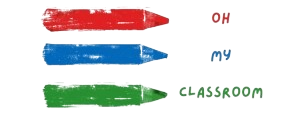Preschool classrooms serve as the launching pad for young minds, where curiosity and imagination take flight.
One of the most effective ways to foster an inviting and stimulating learning space is through colorful decorations.
In this blog post, we will explore colorful preschool classroom decorations ideas.
Decorating a preschool classroom involves creating a vibrant, welcoming, and stimulating environment for young children. Here are some ideas for preschool classroom decorations:
Nature and Seasons:
- Use tree decals, animal cutouts, and seasonal decorations (e.g., leaves for fall, snowflakes for winter).
- Create a nature corner with plants, rocks, and small animal figurines.
Under the Sea:
- Decorate with fish, seaweed, and ocean creatures.
- Hang blue and green streamers from the ceiling to mimic water.
Space and Astronomy:
- Decorate with stars, planets, rockets, and astronauts.
- Create a “space station” reading corner with starry lights.
Rainbow Colors:
- Use bright, multi-colored decorations throughout the room.
- Create a rainbow bulletin board or wall.
Bulletin Boards
Alphabet and Numbers:
- Display colorful letters and numbers.
- Include pictures and objects that start with each letter.
Student Work Showcase:
- Designate a board for displaying children’s artwork and projects.
- Use clothespins or frames for easy updates.
- Interactive Boards:
- Create a weather chart or daily schedule board.
- Use Velcro or magnets for movable parts.
Learning Corners
Reading Nook:
- Include a cozy rug, bean bags, or small chairs.
- Decorate with bookshelves and posters of favorite storybook characters.
Art Station:
- Hang art supplies in accessible containers.
- Display examples of different art techniques.
Science and Exploration:
- Include magnifying glasses, nature collections, and simple experiments.
- Decorate with posters of animals, plants, and planets.
Wall Decorations
Growth Chart:
- Use a fun design, like a tree or rocket, to measure children’s height.
Photo Wall:
- Display photos of the children, their families, and classroom activities.
- Use colorful frames or a themed backdrop.
Inspirational Quotes:
- Use simple, positive quotes or affirmations appropriate for young children.
Ceiling Decorations
Hanging Mobiles:
- Create mobiles with shapes, animals, or planets.
- Use lightweight materials and secure them well.
Paper Lanterns and Pom-Poms:
- Hang colorful paper lanterns or tissue paper pom-poms.
String Lights:
- Use battery-operated string lights to add a cozy glow, especially in reading or nap areas.
Classroom Management Tools
- Behavior Chart:
- Create a positive reinforcement chart with stickers or tokens.
- Use themes like “Super Stars” or “Good Choices Garden.”
- Job Chart:
- Assign classroom responsibilities with a rotating job chart.
- Decorate with pictures and names.
- Calendar and Weather Board:
- Have a daily calendar with the day, date, and weather.
- Use interactive pieces for children to change.
Storage and Organization
- Color-Coded Bins:
- Use bins in different colors for organizing toys, books, and supplies.
- Label them with pictures and words.
- Cubby Area:
- Designate individual cubbies for each child’s belongings.
- Decorate with their names and personal touches.
- Shelf Labels:
- Label shelves with pictures and words to help children find and return items.
Sensory and Play Areas
- Sensory Table:
- Fill with materials like sand, water, rice, or beads.
- Change themes regularly (e.g., beach, construction, garden).
- Dramatic Play Area:
- Create themed play spaces like a kitchen, doctor’s office, or grocery store.
- Decorate with props and related items.
- Puzzle and Game Area:
- Keep puzzles and games accessible and organized.
- Decorate with images of puzzles and favorite games.
These ideas aim to create a dynamic and engaging environment that encourages learning, creativity, and exploration for preschoolers.
Rainbow Wall Display:
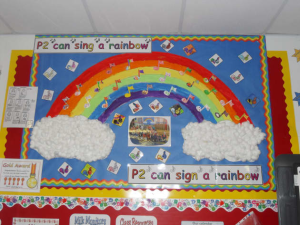
Create a vibrant and engaging rainbow wall display in your preschool classroom. Use colorful construction paper or cardstock to cut out large rainbows in various sizes. Arrange them in a cascading pattern along one wall, starting with the smallest rainbow at the top and gradually increasing the size as you move down. Add clouds and sun cutouts to complete the scene. This colorful display will not only brighten up the classroom but also serve as a visual aid for teaching colors and weather concepts.
Alphabet Color Matching Game:

Enhance your preschoolers’ letter recognition and color matching skills with an interactive alphabet color matching game. Create a large poster or bulletin board featuring the alphabet in uppercase and lowercase letters. Below each letter, attach small pockets or envelopes in different colors. Cut out corresponding colored cards with uppercase and lowercase letters on them. Encourage the children to match the letter cards to the corresponding colored pockets. This activity will make learning the alphabet fun and engaging while also reinforcing color recognition.
Related: 20 Exciting No Prep Get to Know You Games for Kids
Shape Collage Art:
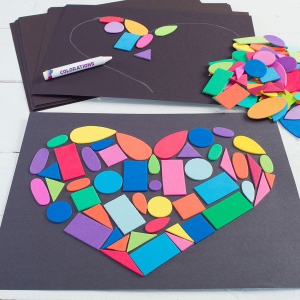
Foster creativity and shape recognition by introducing a shape collage art activity. Cut out large shapes of different colors and sizes from construction paper or foam sheets. Provide the children with a variety of colorful materials such as pom-poms, sequins, buttons, and yarn. Encourage them to create their own unique artwork by arranging and gluing the shapes and materials onto a large sheet of paper or cardboard. This activity allows preschoolers to explore colors, shapes, and textures while expressing their creativity.
Color Sorting Sensory Bins:

Engage your preschoolers’ senses and help them develop their color sorting skills with colorful sensory bins. Fill several plastic bins or trays with different materials in various colors, such as colored rice, pasta, or shredded paper. Provide small objects or toys that match the colors of the bins. Invite the children to sort the objects into their corresponding color bins, promoting color recognition and fine motor skills. Sensory bins not only provide a hands-on learning experience but also offer a fun and engaging way for preschoolers to explore colors and textures.
Related: 20 Great Outdoors Forest School Activity Ideas
Colorful Book Nook:

Create a cozy and inviting reading corner in your preschool classroom with a colorful book nook. Paint a large bookshelf in bright, vibrant colors or use colorful adhesive contact paper to cover it. Arrange the books in rainbow order on the shelves, with each color section clearly labeled. Add comfortable seating, such as bean bags or cushions, and decorate the space with colorful wall decals or posters featuring beloved storybook characters. This visually appealing book nook will inspire a love for reading and provide a stimulating environment for children to explore books and colors.
Color Mixing Science Experiment:

Engage preschoolers in a hands-on science activity that explores color mixing. Set up several stations with small containers of primary colors (red, blue, and yellow) and provide droppers or pipettes. Encourage the children to experiment with mixing the primary colors to create secondary colors (orange, green, and purple). Provide white paper or coffee filters for them to observe and document the color changes. This activity not only teaches color theory but also promotes fine motor skills and scientific exploration.
Color Hunt Nature Walk:

Take your preschoolers on a colorful nature walk to explore and discover colors in the environment. Provide each child with a color wheel or a chart with different colors. Encourage them to look for objects or natural elements in the environment that match the colors on their chart. This activity promotes outdoor exploration, observation skills, and color recognition. Discuss the different colors and objects they find as a group when you return to the classroom.
Colorful Handprint Banner:
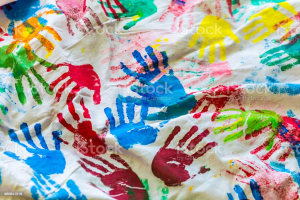
Create a collaborative and decorative art piece with a colorful handprint banner. Provide large sheets of white paper or fabric and a variety of non-toxic, washable paints in different colors. Have the children dip their hands in the paints and make handprints on the sheets. Encourage them to use different colors and create patterns. Once the handprints have dried, cut out the handprints and string them together to create a banner. Hang the banner in the classroom as a colorful reminder of the children’s creativity and teamwork.
Color Sorting Relay Race:

Organize a fun and active color sorting relay race to reinforce color recognition and teamwork. Divide the children into teams and set up stations with colored objects or cones at a distance from the starting line. Each team member takes turns running to the station, picking up an object of a specific color, and placing it in the corresponding basket or bucket at the starting line. The first team to successfully sort all the objects wins. This activity promotes gross motor skills, color recognition, and cooperative play.
Colorful Cooking:
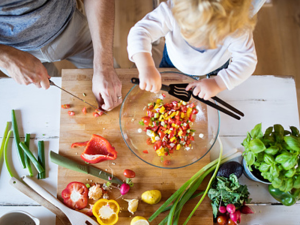
Incorporate colors into a cooking activity that engages preschoolers’ senses and introduces them to different foods. Choose a recipe that allows for the use of colorful ingredients such as fruits, vegetables, or food coloring. For example, you could make fruit skewers with a variety of colorful fruits or prepare rainbow pancakes using food coloring. Involve the children in the preparation process, allowing them to mix and arrange the colorful ingredients. This activity not only introduces healthy eating habits but also promotes color recognition and fine motor skills. Enjoy the colorful and delicious creations together as a group.
Colorful Playdough Sculptures:

Encourage creativity and fine motor skills by providing preschoolers with colorful playdough and various sculpting tools. Set up a playdough station with different colors of playdough and utensils like cookie cutters, rolling pins, and plastic knives. Encourage the children to explore the playdough and create their own colorful sculptures and designs. This activity not only allows them to experiment with colors and textures but also promotes hand-eye coordination and imaginative play.
Colorful Sensory Bottles:
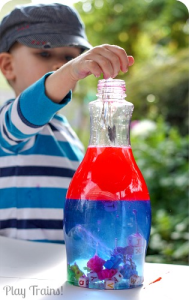
Create mesmerizing sensory bottles using colorful liquids and objects. Fill clear plastic bottles with water and add a few drops of food coloring in different hues. Encourage the children to choose small, colorful objects like sequins, beads, or buttons to add to their bottles. Secure the lids tightly and let the children shake and observe the swirling colors and objects. These sensory bottles provide a calming sensory experience and also serve as a visual tool for teaching colors and cause-and-effect relationships.
Colorful Memory Game:

Enhance memory skills and color recognition with a colorful memory game. Create pairs of cards using colorful construction paper or cardstock. On each pair of cards, draw or attach small pictures or objects in corresponding colors. Place the cards face down and have the children take turns flipping two cards at a time, trying to find matching pairs. This game promotes concentration, visual discrimination, and color recognition, making it a fun and educational activity for preschoolers.
Colorful Dance Party:
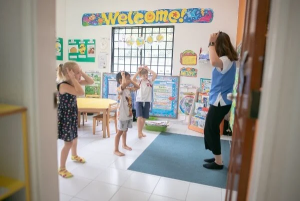
Host a lively and energetic dance party in your preschool classroom, focusing on colors and movement. Play upbeat music with lyrics that mention colors or have a color theme. Encourage the children to dance freely and express themselves through movement and gestures that reflect different colors. You can also provide colorful scarves, ribbons, or streamers for the children to incorporate into their dance routines. This activity promotes gross motor skills, rhythm, and color recognition while fostering a sense of joy and self-expression.
Colorful Science Experiments:

Conduct a series of simple and colorful science experiments that engage preschoolers’ curiosity and promote hands-on learning. For example, you can create fizzing rainbow eruptions by combining baking soda, vinegar, and different colors of food coloring. Another idea is to demonstrate color absorption using white flowers placed in cups of colored water. The children can observe how the flowers change colors as they absorb the colored water. These experiments spark scientific inquiry, teach color concepts, and offer an interactive learning experience for preschoolers.
Colorful Shape Hunt:

Foster shape recognition and color exploration by organizing a colorful shape hunt activity. Create a list of different shapes and assign each shape a specific color. Hide various objects or cutouts representing those shapes and colors around the classroom or outdoor area. Provide the children with a color-coded list and ask them to find and match the shapes to the corresponding colors. This activity encourages observation skills, shape recognition, and color association.
Colorful Sensory Playdough Station:
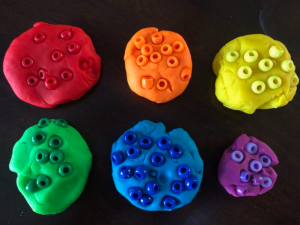
Set up a sensory playdough station with different colors and add sensory elements to enhance the experience. Incorporate materials such as glitter, scented extracts, rice, or small beads into each playdough color. Encourage the children to explore the different textures and scents while manipulating the play dough. This sensory-rich activity promotes fine motor skills, creativity, and sensory exploration.
Colorful Pattern Creation:
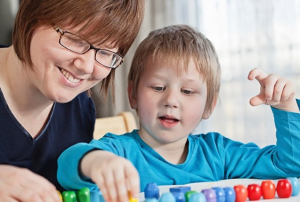
Develop pattern recognition skills by engaging preschoolers in creating colorful patterns. Provide a variety of colored objects such as beads, buttons, or blocks. Encourage the children to create different patterns using colors and objects. Start with simple AB patterns (e.g., red-blue-red-blue) and gradually introduce more complex patterns. This activity stimulates critical thinking, sequencing skills, and color recognition.
Colorful Yoga Adventure:

Combine movement and color recognition with a colorful yoga adventure. Assign each color a specific yoga pose or movement. Create a sequence where the children follow along and perform the yoga poses associated with each color. For example, they can do a tree pose for green, a star pose for yellow, and a cobra pose for red. This activity promotes physical fitness, balance, coordination, and color recognition while encouraging imaginative play.
Colorful Sensory Collage:
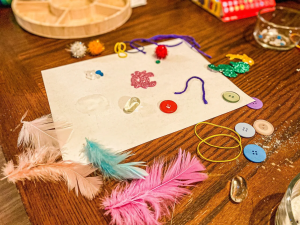
Encourage sensory exploration and artistic expression with a colorful sensory collage activity. Provide a large sheet of cardboard or canvas and a variety of colorful textured materials, such as fabric scraps, tissue paper, feathers, and yarn. Let the children use glue or tape to attach the materials to the surface, creating a vibrant and textured collage. This activity allows them to engage their senses, explore different materials, and create visually stimulating artwork. Display the collages in the classroom to celebrate their creativity and sensory experiences.
